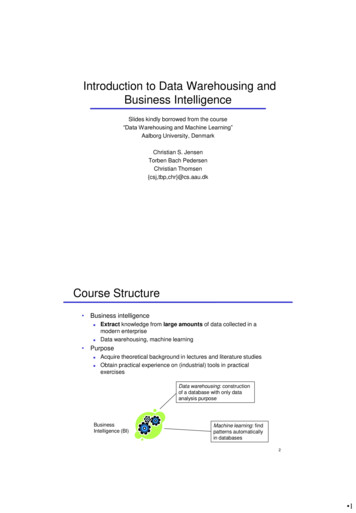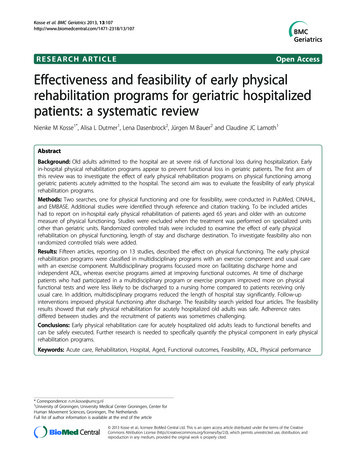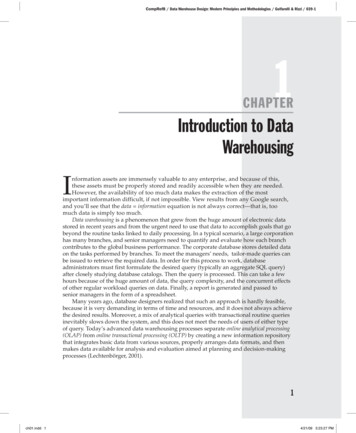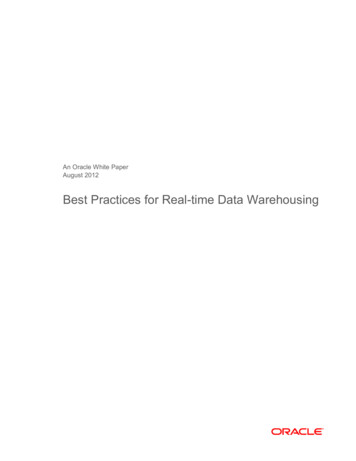
Transcription
WAREHOUSING EFFICIENCY AND EFFECTIVENESSIN THE LOGISTICS MANAGEMENT PROCESSGursharan KaurLecturer, Gobindgarh Public College, Alour, KhannaDr N K BatraPrincipal, University College, Meeranpur, Punjabi UniversityAbstractWarehousing plays a significant role in the overall Logistics Management process. This paper focuses on“back to the basics” that are fundamental for warehouses to achieve both efficiency and effectiveness in logisticsmanagement process. An attempt has been made to study thewarehousing network strategies and the loadingand unloading methods adopted for material handling purposes in the warehouses.Key Words : Warehousing, Logistics Management, Efficiency, Effectiveness.IntroductionIn today’s highly competitive global marketplace, the pressure on organizations to find new ways tocreate value and deliver it to their customers grows ever stronger. The increasing need for industry tocompete with its products in a global market across cost, quality and service dimensions has given rise to theneed to develop more efficient warehousing strategies. Warehousing has come to be recognized as a distinctfunction with the rise of mass production systems. Warehousing is the storage of goods, whereas distributioncenter precedes a post-production warehouse for finished goods held for distribution. Therefore,warehousing and distribution centres basically have the same function of goods and products storage (Coyleat el, 2003). The warehouse and distribution centres are very important nodes in a supply chain network.They perform valuable functions that support the movement of materials, storing goods, processing products,de-aggregating vehicle loads, creating stock keeping unit assortments and assembling shipments (AndreLangevin and Riopel Diana, 2005). The efficient management of warehouses helps to optimise the existingproduction and distribution processes and greatly assist in the goal of cost reduction and serviceenhancement.In today’s competitive environment, companies must operate at maximum efficiency and providesuperior service to ensure profitability. Three factors has been found to affect efficiency and effectiveness ofthe warehouse operations with respect to fast moving consumer goods industry such assimplicity/complexity of the warehouse management systems, product slotting techniques and layoutplanning of the warehouse (Lakmal AGDP and Wickramarachchi WADN, 2011). The organizations ability toeffectively manage the warehouse, reduce costs and fulfillment operations is critical to their success. It ispertinent to mention that the organizations face great challenges in managing warehouses. The role andimportance of warehouses in American economy has been altered to great extent due to changes in the wayof raw materials, intermediate goods, and finished products (John and Bowen, 2008). In the current scenariowhen customer satisfaction and service have become a prime reason for a business to stand apart from itscompetition, the need for effective warehouse management is largely seen more as a necessity. Thus, thewarehouse operating system must be designed for receiving inventory, timely order fulfillment to automatedvalidation of warehouse activities and accurate inventory control to achieve peak performance across theentire enterprise.Warehousing network plays a major role in the success of the physical distribution ofproducts. It is observed that the leading firms adopt and implement the different warehousingstrategies such as capacity switching, hub networking, cobbling and outsourcing (Sople V.V, 2010).Both the analytic and simulation models are proposed for improving warehouse design practices. Analyticmodels are usually design-oriented, explore many alternatives quickly to find solutions. On the other hand,simulation models are usually analysis oriented. They provide an assessment of a given design, but usuallyhave limited capability for exploring the design space. There is an important need to integrate bothapproaches to achieve more flexibility in analyzing warehouse problems (Gu Jinxiang, 2010).
Besides the new trends in supply chains, technology development also has a large impact onwarehousing. Many operations which used to be done manually have now been mechanized or evenautomated. In an automated warehouse, robots might be used to stack incoming products on pallets. Thecontent of each pallet is communicated to the central computer which assigns the pallet to an empty locationin the storage area. Conveyors or Guided Vehicles are used to transport the incoming pallets to the storagebuffer and automated Storage/Retrieval machines are used to store the pallet at the right position in thestorage area (Yu Mengfei, 2008).Objectives of StudyThe main objectives of the study are1. To study the objectives of efficient warehousing operations with respect to companies under study.2. To study the warehousing network strategies followed in organisations under study.3. To analyse the loading and unloading methods adopted for material handling purposes in thewarehouses of companies under study.Research MethodologyThe purpose of the research is to study the objectives of efficient warehousing operations andwarehouse network strategies adopted by the organizations under study. The primary and secondary datahas been collected for the purpose of study. The primary data has been collected with the help ofstructured questionnaire and conducting interviews with employees of concerned department ofcompanies under study. The secondary data has been collected from the records available withmanufacturing units, corporate offices, annual reports, monthly an d annual plan charts, magazines,research journals, publications, studies and articles.The sample of the study includes 84 respondents from the bicycle manufacturing companiesoperating in Punjab. The respondents include the managers and supervisors work ing in ten differentcomplete bicycle manufacturing organizations- two of which belong to organized sector and the rest oforganisations belong to unorganized sector. The manufacturing houses included in the study are Herocycles Limited, Avon Cycles Limited, Seth Industrial Corporation, S. K Bike Pvt. Ltd, Eastman IndustriesLimited, Kohinoor Cycle Pvt. Ltd, Jindal Fine Industries, Ravi Industries, Vishal Cycles Pvt. Ltd andPartap Engineers. The basis for choosing Punjab for carrying out research is due t o concentration ofmore bicycle manufacturing organisations’ in the state and large quantity of production of bicycles inthe state. Ludhiana is hub for bicycle manufacturing in India, producing more than 40000 cycles perday.Data AnalysisIn order to fulfill the objective of the study, both theoretical and empirical studies are conducted. Theempirical study is implemented by interviewing warehouse managers/supervisors of different organizationswith the help of a questionnaire. The data has been analyzed using statistical techniques like percentage,mean and ANOVA.TABLE 1: ANALYSIS OF OBJECTIVES FOR EFFICIENT WAREHOUSING OPERATIONSS. No.MethodsMeanStd.DeviationOne way ANOVAF1.3.90480.481442.Providing timelycustomer serviceKeeping track of items3.85710.518173.Lower operating costs3.39290.791794.Providingcommunication links3.52380.79874Between GroupsWithin GroupsBetween GroupsWithin GroupsBetween GroupsWithin GroupsBetween GroupsWithin 0
5.with customersHigher Inventoryturnover3.57140.69915Between GroupsWithin Groups5.4490.000A warehouse acts as a supporting function for logistics and plays a key role in attaining the overallobjectives of the firm’s logistical supply chain system. The table 1 presents the analysis of objectives ofefficient warehousing operations achieved in the organizations under study. The analysis indicates thatproviding timely customer service is given priority (avg. mean 3.9048) followed by keeping track of items(avg. mean 3.8571) and higher inventory turnover (avg. mean 3.5714). Providing communication links withthe customers (avg. mean 3.5238) and lower operating costs (avg. mean 3.3929). Further, the analysis ofvariance indicates that F value is significantp( .05) for low operating costs (11.248), Providingcommunication links with the customers (10.626) and higher inventory turnover (5.449) implying thatmeans are significantly different from one another. While for providing timely customer service (F 1.082) andkeeping track of items (F 1.032) F value is not significant indicating that means remains same.TABLE 2: WAREHOUSING STRATEGIES FOLLOWED IN ORGANISATIONSS.No.1.2.3.4.Warehousing StrategiesFrequency (N)Percentage (%)Capacity Planned on basis of Average demandWarehousing hubs planned at few strategic locationsSharing of warehouses with non competitors to reduce costOutsourcing84000100000Total84100Warehousing network plays a major role in the success of the physical distribution of products. In thescenario of growing competition and to meet the customer expectations for cost and service, the organizationimplement various warehousing strategies. The table 2 indicates the analysis of warehousing strategiesfollowed in bicycle organizations under study. The data depicts that capacity switching warehousing strategyis adopted by the bicycle manufacturing organizations under study, in which capacity is planned on the basisof average demand.TABLE 3: LOADING AND UNLOADING METHODS ADOPTED IN WAREHOUSESS. No.1.2.3.4.5.6.7.8.Loading and Unloading MethodsFork LiftManualConveyer beltMini craneCounter balanced truckElectric BikeManual and Conveyer beltManual and Conveyer belt and Electric bikeTotalFrequency (N)0620000121084Percentage (%)073.8000014.311.9100The productive potential in logistics can be exploited by selecting right type of handling equipment.For moving in and out of warehouse, various kinds of equipment and systems are used depending on the typeof products. The table 3 presents the analysis of loading and unloading methods used in the warehouses forhandling purposes. The analysis indicates that 73.8% of respondents state that manual methods are used forloading and unloading of goods in the warehouses, whereas 14.3% respondents opined that conveyer beltsare used along with the manual methods for loading and unloading purposes. The rest of 11.9% respondents’state that electric bikes are also used in addition to manual and conveyer belt methods.
Conclusion & SuggestionsThis study has identified some important findings for efficient warehouse management operations. Awarehouse acts as a supporting function for logistics and plays a key role in attaining the overall objective ofthe firm’s logistical supply chain system. The performance of the warehouse is judged by its operations suchas timely customer service, keeping track of items, lower operating costs, damage free delivery and higherinventory turnover. We conclude that the effectiveness of overall operations of a company can beconsiderably enhanced by proper decision on objectives for efficient warehousing. Warehousing networkplays a major role in the success of the physical distribution of products. In the scenario of growingcompetition and to meet the customer expectations for cost and service, implementation of appropriatewarehousing strategies play significant role. The study suggests that in order to meet the customerexpectations for cost and service, the organization can follow capacity switching strategy, where the capacityof a warehouse is planned on the basis of average demand per month over the year.Material handling function also has an effect on the efficiency and the speed of the warehousingoperations. The materials, spare and finished goods can be moved in and out of warehouse manually or usingvarious kinds of equipment and systems. The efficiency of material handling process adds to the performancelevel of the warehouse. The reduction of labour and enhancement of productivity could be achieved by usingemerging technologies in material handling. The sophisticated systems such as robotics, conveyer belt, forklift, cranes, electric bike etc could be used in warehouses and performing other functions for speedy materialmovement. The bicycle manufacturing organizations’ could reframe and redesign their strategies according totheir needs and requirements.References1.2.3.4.5.6.7.8.9.Andre Langevin, Riopel Diana (2005) Logistics Systems: Design and Optimization, Springer, New York.Coyle J.J., Bardi E.J., Langley C.J. Jr. (2003) The Management of Business Logistic: A Supply Chain Perspective,(7th Ed.) Cincinnati, Ohio: South-Western/Thomson Learning, Cop. 2003.Gu Jinxiang, Goetschalckx Marc, McGinnisLeon F. (2010) Research on Warehouse Design and PerformanceEvaluation: A Comprehensive Review, European Journal of Operational Research, 203, 539–549.John and Bowen (2008) Moving Places: The Geography of Warehousing in the US, Journal of TransportGeography 16 (2): 379-387.Kothari C.R (2009) An Introduction to Operational Research, Vikas Publishing House Pvt. Ltd, Noida.Lakmal AGDP, Wickramarachchi WADN (2011) Enhancing the Effectiveness and Efficiency of WarehouseOperations in FMCG Sector in Sri Lanka, 17th ERU Research Symposium, Faculty Of Engineering, University ofMoratuwa, Sri Lanka.Panneerselvan R (2008) Production and Operation Management, PHI Learning Private Limited, New Delhi.Sople V. V. (2010) Logistics Management, Dorling Kindersley (India) Pvt. Limited, New Delhi.Yu Mengfei (2008) Enhancing Warehouse Performance by Efficient Order Picking, PhD Thesis submitted atErasmus Research Institute of Management, RSM Erasmus University / Erasmus School of Economics ErasmusUniversity, Rotterdam.
This study has identified some important findings for efficient warehouse management operations. A warehouse acts as a supporting function for logistics and plays a key role in attaining the overall objective of the firm’s logistical supply chain system. The performance of the warehouse is judged by its operations such as timely customer service, keeping track of items, lower operating costs .











